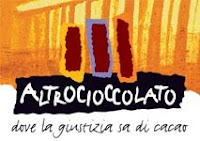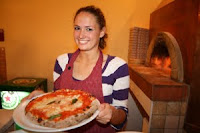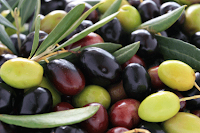Category: Umbra Blog
This blog documents the experiences of students currently studying at the Umbra Institute in Perugia, Italy, offering an account of their day-to-day experiences, extra- and co-curricular activities, and special events. We hope you gain some insight into what adventures Umbra students find outside the classroom during their semester in Perugia, a medieval town in the mountains of Umbria. Cheers!
 Though the tents that shelter all the stands haven’t started appearing yet in Corso Vannucci, the Eurochocolate “Festival” isn’t far away. Perugia’s famous for that felicitous marriage of cocoa, milk, and sugar because of the long tradition of chocolate here (beginning with the Perugina Confectionery Company, born over a hundred years ago), and the city rightly becomes the temporary capital of dark sweetness every October.But this year, as for the past ten years, there will be an alternative to the fast-food approach to chocolate.
Though the tents that shelter all the stands haven’t started appearing yet in Corso Vannucci, the Eurochocolate “Festival” isn’t far away. Perugia’s famous for that felicitous marriage of cocoa, milk, and sugar because of the long tradition of chocolate here (beginning with the Perugina Confectionery Company, born over a hundred years ago), and the city rightly becomes the temporary capital of dark sweetness every October.But this year, as for the past ten years, there will be an alternative to the fast-food approach to chocolate.
Altrocioccolato (literally “another chocolate”), a festival organized to promote fair trade brands, will be held in the nearby city of Castiglione del Lago from October 15th to 17th. In addition to free concerts and seminars about fair trade, the festival will feature (of course!) fair trade chocolate from all over the world.
Yesterday night the Birraio hosted the Umbra Institute’s welcome back aperitivo. Students tired from all of their Fall Break travel were able to kick back on the Birraio’s comfy couch-seats and have a bite to eat while recounting their adventures in foreign capitals. The evening was enlivened by an unexpected power outage: the lights went but the candles stayed on, creating an even better atmosphere for travel tales. Next up on the Umbra calendar: next week’s Cheese Workshop (sign up with Zach or Ian).
 This could have been the name of last night’s lecture…had it been a lecture! Instead it was the Umbra Institute’s Pizza Workshop, a hot-baked mix of the history and biochemistry of pizza, followed by the main course, the pizza itself. Fifteen Umbra students followed staff member Zach Nowak down into the medieval Via della Viola neighborhood to the pizzeria “Pizza e Musica,” located in a nook (a former convent).
This could have been the name of last night’s lecture…had it been a lecture! Instead it was the Umbra Institute’s Pizza Workshop, a hot-baked mix of the history and biochemistry of pizza, followed by the main course, the pizza itself. Fifteen Umbra students followed staff member Zach Nowak down into the medieval Via della Viola neighborhood to the pizzeria “Pizza e Musica,” located in a nook (a former convent).

Pizza e Musica, like many “neighborhood pizzerias,” has no sign, but it does have heart. Head pizzaiolo (pizza-maker) Felice, a Neapolitan through-and-through, welcomed the students into the pizzeria. Nowak took a turn explaining some of the history of the pizza (including a digression on how the Pizza Margherita supposedly got its name) and how the dough rises.
This was followed by the geography of heat in the oven: every pizzaiolo needs to know where the warm and cold spots are in his or her oven, and how to use these differences in heat to make all the pizzas come out at the same time.
 Arguably (well, actually no one present would have argued his) the best part of the night was the practical side of the workshop. Three students had the chance to get behind the marble pizza counter and stretch out their dough, adding toppings galore. Despite their inexperience, all three made up delicious pizzas for their classmates. And after that, everyone sat down and had yet another pizza for a perfect, tomato-topped conclusion to the evening.
Arguably (well, actually no one present would have argued his) the best part of the night was the practical side of the workshop. Three students had the chance to get behind the marble pizza counter and stretch out their dough, adding toppings galore. Despite their inexperience, all three made up delicious pizzas for their classmates. And after that, everyone sat down and had yet another pizza for a perfect, tomato-topped conclusion to the evening.
In the photos: Devon Forbes, Matt Wischerth, and Emerson Oronte
.
This past Tuesday night, students in Professor Antonella Valoroso’s Honors class spent a night at the Opera. The show of choice: L’Elisir d’Amore (performed at Teatro Morlacchi) written by Gaetano Donizetti in 1832. Donizetti wrote this opera in only seven days after the previous opera writer at the Teatro della Canobbiana in Milan had quit, Professor Valoroso explained during intermission. It is now one of the 20 most preformed operas in North America. With its light-hearted music and silly love tale, students were enchanted not only by Donizetti’s work but also by the theater itself. Teatro Morlacchi was built in the 1800s and became the theater of Perugia’s new middle class.
Students laughed along with the rest of the audience at the story of the poor, enamored peasant Nemorino. He is deeply in love with Adina and buys a L’Elisir d’Amore (love potion) from the traveling salesman and quack, Dr Dulcamara. Unbeknown-est to him, the bottle of love potion contains only wine! Filled with delightful songs and the famous aria “Una furtiva lagrima” students needed no L’Elisir d’Amore to fall in love with this comedic opera!
(pictured from left to right: Elise Fitzgerald, Alex Hanken, Justin Baldassare, Caroline Dallas)
 With a needle and thread in hand, students began sewing their very own Pigotta doll for UNICEF, the United Nations Children’s Fund. Every week, student volunteers will work towards creating these special handmade dolls, the very symbol of UNICEF in Italy. Each doll helps raise enough money to fund a vaccine kit protecting a child against deadly diseases in developing countries. Students sew alongside Italian university students and UNICEF volunteers in the beautifully frescoed UNICEF office, only a 10 minute walk from Umbra Institute. The UNICEF volunteers warm, caring energy makes it is easy and fun for all novice seamstresses and seamsters to enjoy themselves and learn a few tricks of the trade. It is the perfect opportunity for the student volunteers to learn Italian, make new friends, and be proud of their generous donation to a global cause.
With a needle and thread in hand, students began sewing their very own Pigotta doll for UNICEF, the United Nations Children’s Fund. Every week, student volunteers will work towards creating these special handmade dolls, the very symbol of UNICEF in Italy. Each doll helps raise enough money to fund a vaccine kit protecting a child against deadly diseases in developing countries. Students sew alongside Italian university students and UNICEF volunteers in the beautifully frescoed UNICEF office, only a 10 minute walk from Umbra Institute. The UNICEF volunteers warm, caring energy makes it is easy and fun for all novice seamstresses and seamsters to enjoy themselves and learn a few tricks of the trade. It is the perfect opportunity for the student volunteers to learn Italian, make new friends, and be proud of their generous donation to a global cause.
Umbra students benefit from helping others with community engagement activities.
 With a needle and thread in hand, students began sewing their very own Pigotta doll for UNICEF, the United Nations Children’s Fund. Every week, student volunteers will work towards creating these special handmade dolls, the very symbol of UNICEF in Italy. Each doll helps raise enough money to fund a vaccine kit protecting a child against deadly diseases in developing countries.
With a needle and thread in hand, students began sewing their very own Pigotta doll for UNICEF, the United Nations Children’s Fund. Every week, student volunteers will work towards creating these special handmade dolls, the very symbol of UNICEF in Italy. Each doll helps raise enough money to fund a vaccine kit protecting a child against deadly diseases in developing countries.
Students sew alongside Italian university students and UNICEF volunteers in the beautifully frescoed UNICEF office, only a 10 minute walk from Umbra Institute. The UNICEF volunteers warm, caring energy makes it is easy and fun for all novice seamstresses and seamsters to enjoy themselves and learn a few tricks of the trade. It is the perfect opportunity for the student volunteers to learn Italian, make new friends, and be proud of their generous donation to a global cause.
This past weekend, thirty-six Umbra students headed to the beautiful “peninsula Sorrentina” to enjoy summer’s final encore. After getting rained on a little in Pompeii on Friday, the sun came out on Saturday afternoon in Capri, accompanying the group on a rocky but thrilling ferry ride back to Sorrento, continuing to warm things up in Naples on a bustling Sunday morning. Good meals were eaten, interesting tours were taken and some students even went on a swim in Capri’s irresistible, emerald-green waters. All in all it was a great way to send off the summer and step steadily back into Perugia’s brisk, crisp fall air.
 This past Friday the Italy of the Imagination creative writing class took a trip to Citta’ di Castello, a nearby Umbrian city, to see the place where manuscripts become books. Umbra professor Cynthia Clough arranged the visit to the the Printing Museum, home of the oldest still-functioning printing presses in Europe (and likely in the whole world).
This past Friday the Italy of the Imagination creative writing class took a trip to Citta’ di Castello, a nearby Umbrian city, to see the place where manuscripts become books. Umbra professor Cynthia Clough arranged the visit to the the Printing Museum, home of the oldest still-functioning printing presses in Europe (and likely in the whole world).
Gianni Donati, a seventh-generation printer, was the students’ guide for the visit, explaining the transition from early wooden engravings to Gutenberg’s revolutionary movable type, as well as several other processes (copperplate and lithograph). Each took home several prints made with Donati’s century-and-a-half old Wittenberg press. This trip is one of a series of co-curricular trips that Umbra Institute professors use to reinforce concepts learned in the classroom.
 The last week has seen a slow creep towards Autumn in Umbria. Heavier blankets have come down out of the attics, and on the Steps of the cathedral (ever the focal point of Perugia’s social life) t-shirts and shorts have been replaced by long sleeves and jeans. It’s hardly dramatic, as Umbria’s sun never goes behind clouds for too long, even in the depths of winter, and to boot Fall in Umbria means gastronomic treats.
The last week has seen a slow creep towards Autumn in Umbria. Heavier blankets have come down out of the attics, and on the Steps of the cathedral (ever the focal point of Perugia’s social life) t-shirts and shorts have been replaced by long sleeves and jeans. It’s hardly dramatic, as Umbria’s sun never goes behind clouds for too long, even in the depths of winter, and to boot Fall in Umbria means gastronomic treats.
Fairly soon farmers will head out with their green nylon nets to harvest olives: the first press in  Umbria is almost always extra-virgin level, attacks your palate and makes the olive oil of last year seem drab. Then, in early November, central Italians celebrate San Martino, Saint Martin’s feast day: vino novello and roasted chestnuts are the main event. No more ice cream, but there are some consolation prizes. Buon autunno!
Umbria is almost always extra-virgin level, attacks your palate and makes the olive oil of last year seem drab. Then, in early November, central Italians celebrate San Martino, Saint Martin’s feast day: vino novello and roasted chestnuts are the main event. No more ice cream, but there are some consolation prizes. Buon autunno!


